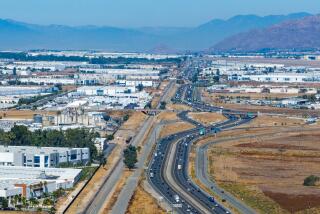Camarillo in West County Race to Lure Compatible Businesses : Economy: Bouncing back after the ’92 loss of a major employer, the city courts development fit for a suburban environment.
- Share via
Although it still aspires to being little more than a comfortable bedroom community, Camarillo has joined the race among west county cities in the heated battle for sales-tax dollars.
It was not always that way.
In fact, it took the loss of a few longtime corporate residents to wake up Camarillo officials to the need to enter the battle.
One major casualty came in 1992, when wheelchair maker Everest & Jennings announced that it was moving out of its sprawling Camarillo plant to a new facility in St. Louis, taking with it about 400 jobs.
Company officials said the move was being made to take advantage of lower taxes and a more business-friendly environment.
“We first learned about it in the paper,” said Councilman David Smith. “The Everest & Jennings officials were quoted as saying that we, the city, didn’t really care that they were leaving. I think we all vowed never to let something like that happen again if we could possibly prevent it.”
The departure spurred the council to create a committee that would concentrate on economic development, Smith said. And with the help of an economic development consultant who was hired last year, city officials say they are beginning to reap the benefits of the campaign.
But city officials say they want to lure projects that are good for Camarillo--not just those that will guarantee headlines for the city of 56,500.
“You can call it civic pride or just a keen sense of knowing what our specific needs are,” said Assistant City Manager Larry Davis.
One need, Camarillo officials admit, is to develop more sales-tax revenues while retaining the city’s suburban, agriculturally oriented environment.
To that end, the 19.2-square-mile city recently has given the go-ahead to several large entertainment, retail and business developments.
Along with the recent opening of the Camarillo Factory Stores mall, a 12-screen Edwards Theatres cineplex has opened off Ventura Boulevard and a similar-sized United Artists movie house is under construction in the city’s Mission Oaks area. City officials project that the factory outlet alone will generate $400,000 to $500,000 annually in sales tax revenues.
In January, officials of WellPoint Health Networks, a for-profit subsidiary of Blue Cross of California, announced they will consolidate their Thousand Oaks and Newbury Park operations into a 61-acre headquarters complex to be built on Camarillo’s east side.
And last month, the council approved the development of a 39-acre parcel near Las Posas Road and the Ventura Freeway that will feature a 116,000-square-foot Target discount store and about 20 other shops and restaurants.
Councilman Stan Daily, who along with Smith sits on the council’s economic development committee, said Camarillo had a long-held reputation as a tough city in which to get projects developed. Now, Daily said, city staff members and the council are trying to work with developers to make their projects acceptable to the city.
“I think it’s a reputation that we deserved, but we have really worked hard to move away from that,” Daily said. “I’m proud of the work we have done to streamline our permitting process. I think we have our own vision of the future, and I think we know how to get there.”
*
James Jevens, the council’s economic development consultant, agreed with Daily. But he added that before California--like the rest of the nation--slipped into a deep recession several years ago, the city had the luxury of being extremely selective when it came time to approve or deny projects.
“Obviously, all of that changed with the recession,” Jevens said. “Suddenly, the city found that it was competing toe-to-toe with the likes of Simi Valley, Thousand Oaks and Agoura. It’s something the city never had to worry about before.”
Meanwhile, Camarillo was watching Ventura and Oxnard increase their tax bases, Ventura by pitching itself as a regional tourist destination and Oxnard by developing large parcels on the city’s east side as business parks and light manufacturing zones.
Camarillo, which has an annual budget of $27 million for 1994-95, does not assess property taxes on its residents and contracts with many outside companies and agencies to provide many services--including police and fire--to its residents.
Jevens said his work is now focusing on the creation of so-called business “incubator” spaces designed to attract small high-tech or biomedical start-up companies.
With the help of state and federal grants, Camarillo hopes to lure these small firms to the city, using them as seed companies to attract similar businesses.
“We’re very excited about the prospects of this program,” Jevens said. “If it works, it will bring the kind of clean, non-polluting companies that we want to our city. We’re hoping it’s going to fly.”
Officials are divided on whether Camarillo, which prides itself on its low crime and low unemployment rates, should ally itself with other west county cities or go it alone.
Davis said cooperation hasn’t worked in the past.
“With the exception of a few programs, we have stayed away from any joint developments with the other cities,” Davis said. “It just seems like people could never get past all the infighting.”
But Sherry Cole, president of the Camarillo Chamber of Commerce, said that though the city is now busy building up its own economy, the need for joint cooperation among west Ventura County cities will become apparent as populations grow.
“I think it’s inevitable,” Cole said. “In order to counteract the flight of companies, I think you’ll see increasing cooperation between the cities in this county--Camarillo included. For now, however, we strongly support Camarillo’s efforts to increase and solidify its sales-tax revenues.”
More to Read
Sign up for Essential California
The most important California stories and recommendations in your inbox every morning.
You may occasionally receive promotional content from the Los Angeles Times.










